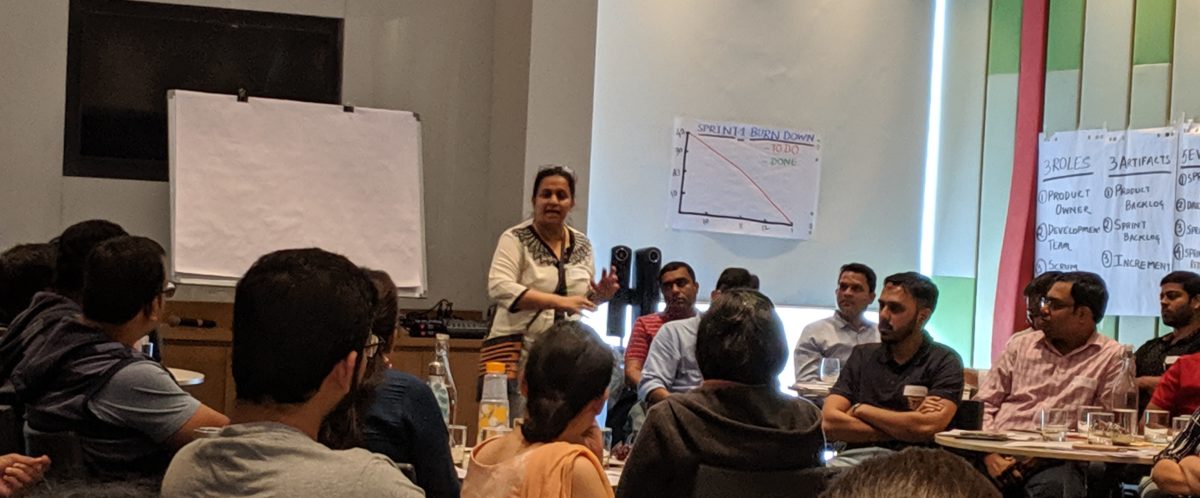It is a common mis-conception that Scrum is only useful for small projects.
The real fact is that Scrum is used for solving complex problems. Complex problem is a problem where there are “unknowns” about requirements or the solution.
For solving complex problems, the decisions have to be taken based on what has been done in the recent past. It is extremely difficult to base your decisions based on long-term assumptions. This way of solving problems is called Empiricism or Empirical process control. Scrum is a framework based on Empirical Process Control Theory and therefore, used for solving complex problems.
A complex problem may be big or small. Therefore, the size of the problem has nothing to do with usage of Scrum or other frameworks/methods. A few examples of massive complex problems
- Merger or separation of a bank – When two banks merge or separate, there are a lot of unknown factors on the products in the resultant merged or separated bank. For example, one bank may be a risk-taking bank have an investment product based on a mix of equity, commodities, and derivatives, whereas, second bank might have a more conservative approach based on fixed-deposits, company-fixed-deposits of blue-chip companies and debt market involving only government securities. Now what would be the product applicable for the new merged bank? Would both products be offered by the new bank or would they be another combination product, or if the merged bank carries the image of the conservative bank then should it even offer the risky product? There are a lot of unknowns here. Would the image of a new merged bank be conservative or risk taking? Would the customers of the risk-taking bank accept the conservative products? Would the customers of the conservative bank accept the risky products or accept a risky profile of the new merged bank? This is an example of an unknown scenario. Unless things are tried out, there is no way you could take decisions. As a business, you may try various combinations, but the answers are possible only after trying different products and taking feedback from customers.
- Development of a medicine or vaccine for an unpredictable disease – The whole world grappled with the Covid-19 pandemic in 2020. The solution to solve this problem was two-fold – either develop a vaccine to prevent the disease or develop a medicine to kill the virus if anyone gets infected. Both were big unknowns. How the infections spread was unpredictable and also how the disease affects the patients was also unpredictable. Scientists and researchers had no option but to use the trial-and-error approach based on the past knowledge of various viruses. However, the majority of the decisions were based on what was the result of the trails done on various animals and eventually on human beings. Again a complex problem where decision can only be taken based on what has been done in the recent past. The decisions cannot be taken based on long-term planning.
Naturally, the approach for solving these kinds of problems is to shorten your planning horizons, try out things, if things do not work then try something else, if things work then try something else to make the solution stronger. So isn’t Scrum a way of solving such problems? Scrum shortens the planning horizon to maximum one month, then uses the inspect-adapt cycles (at the bare-minimum) through Sprint Reviews, Daily Scrums and Sprint Planning. The implementation of the Product Backlog is in-fact a way of adapting the requirements as you move forward and as more is known about the problem you are solving.
Therefore, it is a myth that Scrum is for small projects.
Conclusion
The size of the project has nothing to do with the use of Scrum or not.
- Scrum is based on Empirical Process Control Theory. Empiricism asserts that knowledge comes from experience and making decisions based on what is observed.
- Scrum combines four formal events (Sprint Planning, Daily Scrum, Sprint Review and Sprint Retrospective within a containing event, the Sprint) and three Artifacts (Product Backlog, Sprint Backlog and Increment) to implement empiricism. These events work because they implement the empiricism pillars of transparency, inspection, and adaptation.
- Thus, Scrum is being used for solving complex problems (unknown requirements or unknown solutions) for small as well as large projects where constant inspection and adaptation is necessary and decisions have to be taken based on what is observed. Scrum Team observes what is happening based on the feedback received and adapts to the changes.
This article is re-published on WORLD OF AGILE website –https://worldofagile.com/blog/myth-about-scrum-only-being-useful-for-small-projects/
